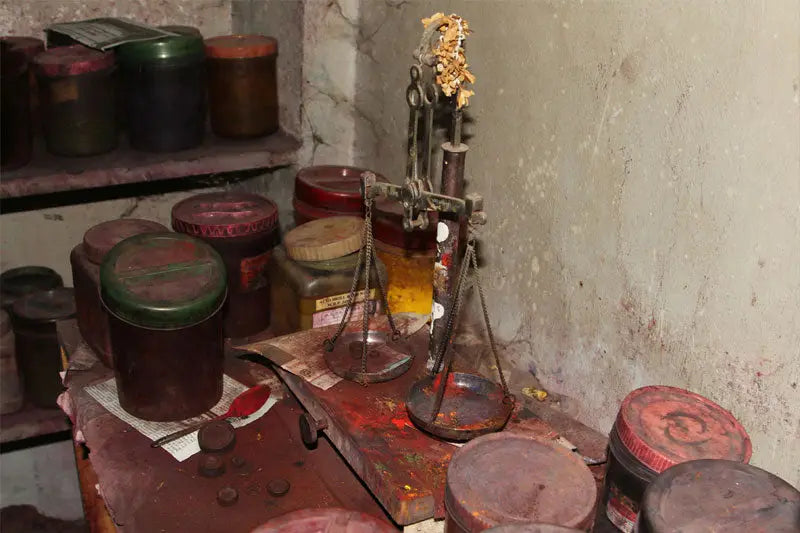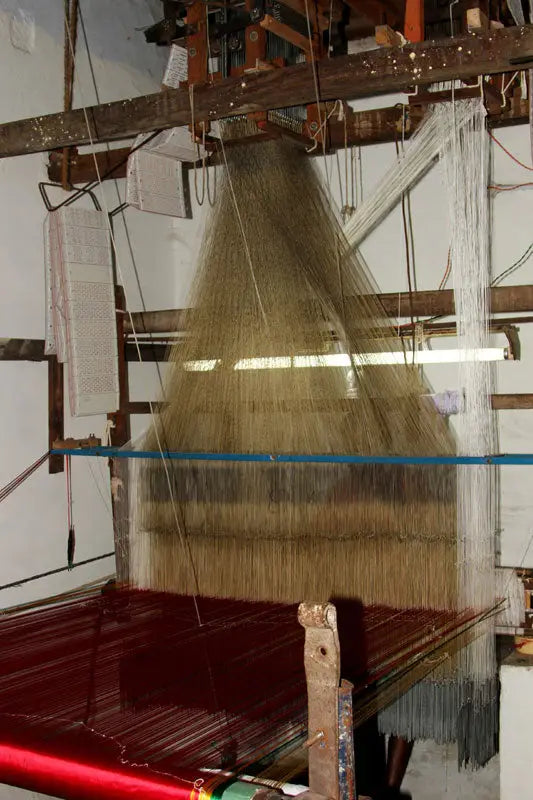All you need to know about Kanchipuram weaving:
Exclusively known for rich and bold gold borders, along with delicate brocade in contrasting colors, Kanchipuram weavings are one of the most elegant styles in the business. It has been adorned by Indian women for over 150 years, and has maintained its position as one of the best and most sophisticated fabrics that are worn for occasions that are meant for the best of the best. Originated in the ‘City of Silk’ - Kanchipuram, this type of weaving has become historic and is one of the most esteemed.
Details on the weaving style:
Kanchipuram weaving is known to be purely woven, and is done using processed silk yarn, as well as Zari, which are silk threads that are produced and made of silver and gold materials. The most famous and specialized sari of this weave is the ‘Murukku pattu’, which is a heavy silk saree that is woven with silk yarn, which is of the three-ply silk type, and zari.
The weavers are most known for producing rich gold borders and traditional designs in contrast and beautiful colors. Original Kanchipuram sarees have prices between 5k to about 1 lakh 50 thousand, and the most expensive sarees are the ones that have pure zari work done on them, and are usually worn for occasions like weddings.
"Over 5000 families of Kanchipuram are involved in the business of producing silk sarees, and this profession is a steady source of income for over 45,000 weavers. This skill is practiced in many other areas of Tamil Nadu, such as Rasipuram, Mannarkudi and even Kumbakonam."
The process includes initially acquiring and gathering the raw materials. The basic materials are mulberry silk, zari, dye color and rice starch. The silk material is known to be produced from Karnataka and is tough, yet maintains the texture of silk by being soft, which adds a smooth luster and shine to the saree. The zari threads which are coated gold are used on the border or ‘pallu’ of the saree and is imported from the city of Surat, in Gujarat. Local markets are the source from where the weavers procure dye colors, and mix the color powder with boiling water in large copper vessels. Some weavers also tend to use pre-coloured silk threads. Lately, the rice starch, which is natively known as ‘Kanji’ is used to add the stiffness to the yarn before it is used in the weaving process.
Image Credit: D'Source
Process of weaving:
The raw silk that is procured is divided into three parts and dyed into the same number of colors to get the end result of three different colors of sarees. The dyeing process starts with boiling water in huge copper containers, and once it reaches a high temperature, the dye color along with material such as soap oil and washing soda are added to the mix. Off-white silk yarn is then dipped into the mixture and then dropped into a vessel of normal water, to wash off any of the excess colors, and then left to dry for 2-3 days. The most usual colors used for this are reds, green, blue and variations of yellow color.

Image Credit: D'Source
The silk and zari are separated before getting worked on by the weaving loom, by using a wheel and weaving horizontally. The tangles and uneven surfaces on the silk threads are also separated. The set apart silk threads are attached to the weaving loom from end to end and maintained together to stitch the saree. There are continuous pages of cardboard stencils on the wheel that move along with the stitching, on which the designs are first drawn and cut into as a stencil.

Image Credit: D'Source
The pallu and borders of these fabrics are embellished with beautiful graphic motifs and intricate variations of designs, most of which are inspired by temples, as well as birds, flowers and even statues.
Future of Kanchipuram:
The textile and fashion industry has grown hugely in the past couple of decades, and this has resulted in a lot of new machinery and techniques to be incorporated into the business. This development has led to a number of changes, including the process of weaving for the weavers, and how it affects their livelihood. Most machines work faster than manual labor, hence eliminating human workers from weaving factories in some areas and regions, while many others keep the method traditional and maintain handiwork. Much of the raw material provided does not turn out to be pure, in order to be more cost-efficient, but most customers can’t tell the difference and end up paying the original prices for a duplicate.
Kanchipuram sarees and weaving techniques are still held in high regard after so many years of its initiation and are held closely by many women, and passed on from generation to generation and heirlooms as well.
iTokri’s affiliation with Kanchipuram Weaving:
Over the years, this weaving has shifted from sarees and started being incorporated in even dresses and other cloth fabrics. Our website for Itkori has an amazing variety of this beautiful weave pattern. One of these is the beautiful and comfortable Kanchipuram Checkered Kaftans, which are so easy to pull off and wear for any casual occasion, while giving the elegance of the weave and keeping it intact. There are also some modern renditions of Kanchipuram weave cotton buti blouses that are available. Another more traditional product available on Itokri are the Kanchipuram Cotton Buti fabrics with thread borders, which are simple and elegant fabrics that stick with the generational culture and tradition of the weave, and are sold by the meter.

Over the years, the weavers and weaving process of Kanchipuram have evolved and progressed in many ways, but the love and desire that most women, and their families have for the possession of the sarees has stayed constant. The trust with with the weavings are demonstrated, the tediousness that goes behind the preparation process of the raw materials and procurement, and the grace and detailing with which the embossments and graphic designs and embellished on the fabrics, makes Kanchipuram weaved fabrics one of the most sought after handicrafts in the Indian sub-continent.
Blogs you might also like:
Significance of Wearing Nose Pins
Ajrakh-Aa-Tales
Pochampally Ikat - Excerpts from conversation
REFERENCES
https://www.nsoj.in/stories/the-weavers-of-kanchipuram
https://www.dsource.in/resource/silk-weaving-kanchipuram/introduction
https://www.itokri.com/products/2022-412-1-128-kanchipuram-cotton-buti-fabric-with-thread-border
https://www.itokri.com/products/2022-654-1-4-kanchipuram-checks-cotton-knee-length-kaftan-with-tie-up-waist
 Verified Purchase
Verified Purchase




































































































































































































Leave a comment (all fields required)